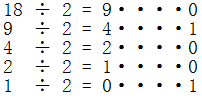《JavaScript高级程序设计》读书笔记
《JavaScript高级程序设计》读书笔记
kbit/s
数据传送率的单位.意思是每秒钟多少千字节.比如20Kbit/s就是每秒钟20000个字节.一般上网、下载的速度用这个单位.adsl宽带上网下载速度大概为30-50Kbit/s.
JavaScript的组成
JavaScript由ECMAScript(JavaScript的版本)、DOM(文档对象模型)、BOM(浏览器对象模型)三部分组成
开启严格模式的方法
在js脚本的最顶部添加下面一段代码
"use strict"创建全局变量的方法
方法1:在函数外部定义一个变量,在函数内部使用变量
var message;
function test() {
message = "hello world";
}
test();
alert(message);方法2:在函数内部定义变量,并且不写var操作符
function test() {
message = "hello world";
}
test();
alert(message);将十进制转换成二进制的方法
除二取余,倒序排列。例如将十进制的18转换成二进制 第一步:计算除二取余

第二步:将余数倒序排列就可以得到18的二进制是10010
将十进制的负数转换成二进制
负数的二进制是用负数的绝对值的补码表示,以计算-18的二进制为例介绍负数的二进制计算方法 第一步:计算-18的绝对值 |-18| = 18 第二步:计算18的二进制 0000 0000 0000 0000 0000 0000 0001 0010 第三步:计算二进制的反码 1111 1111 1111 1111 1111 1111 1110 1101 第四步:将反码加1 1111 1111 1111 1111 1111 1111 1110 1110 所以-18的二进制值 1111 1111 1111 1111 1111 1111 1110 1110,其中第31位表示的是符号位不参与计算,1表示是负数,0表示是正数,位的顺序是从右往左排列的从0开始,也就是所最右边的哪位是第0位,然后往左依次是1、2、3、……位以此类推,最后一位是第31位
计算按位非操作的简便方法
操作数的负值减1,例如计算25的按位非操作的方法如下
var num1 = 25;
var num2 = -num1 - 1;获得变量的基本数据类型
JavaScript中使用typeof关键字获得变量的基本数据类型
var s = "Nicholas";
var b = true;
var i = 22;
var u;
var n = null;
var o = new Object();
alert(typeof s); //string
alert(typeof i); //number
alert(typeof b); //boolean
alert(typeof u); //undefined
alert(typeof n); //object
alert(typeof o); //object判断变量的引用的数据类型
JavaScript中使用instanceof关键字判断变量的引用数据类型
var person = new Object();
var colors = [];
var pattern = new RegExp();
alert(person instanceof Object); //变量person是Object类型吗
alert(colors instanceof Array); //变量colors是Array类型吗
alert(pattern instanceof RegExp); //变量pattern是RegExp类型吗JavaScript的基本数据类型
JavaScript一共有5种基本数据类型,分别是Undefined、Null、Boolean、Number和String。
JavaScript中的引用类型
常见的引用类型:Object、Array、Function、RegExp
构造函数
构造函数的定义:构造函数是一种特殊的方法,主要用在创建对象时初始化对象,即为对象成员变量赋初始值,总与new运算符一起使用在创建对象的语句中
构造函数的特点:
- 构造函数的函数名和类名相同
- 构造函数定义时没有返回值
- 构造函数只能用于定义对象时初始化对象
创建数组的方式
方式1:使用Array的构造函数创建数组
//创建一个空数组
var colors = new Array();
//创建一个保存20个数据的数组
var colors = new Array(20);
//创建一个保存了3个字符串的数组
var colors = new Array("red", "blue", "green");方式2:使用Array的构造函数创建数组时也可以省略new操作符
//创建一个空数组
var colors = Array();
//创建一个保存20个数据的数组
var colors = Array(20);
//创建一个包含3个字符串的数组
var colors = Array("red", "blue", "green");方式3:使用数组的字面量创建数组
//创建一个空数组
var colors = [];
//创建一个包含3个字符串的数组
var colors = ["red", "blue", "green"];栈与队列
栈的访问规则:先进后出 队列的访问规则:先进先出
JavaScript中创建对象的方式
方式1:使用Object创建对象
var person = new Object();
person.name = "Nicholas";
person.age = 29;
person.job = "Software Engineer";
person.showName = function () {
console.log(this.name);
}
person.showAge = function () {
console.log(this.age);
}
person.showJob = function () {
console.log(this.job);
}方式2:用对象字面量语法创建对象
var person = {
name: "Nicholas",
age: 29,
job: "Software Engineer",
showName: function () {
console.log(this.name);
},
showAge: function () {
console.log(this.age);
},
showJob: function () {
console.log(this.job);
}
};方法3:用函数封装特定接口创建对象
function createPerson(name, age, job) {
var o = new Object();
o.name = name;
o.age = age;
o.job = job;
o.showName = function () {
console.log(this.name);
};
o.showAge = function () {
console.log(this.age);
};
o.showJob = function () {
console.log(this.job);
};
return o;
}
var person1 = createPerson("Nicholas", 29, "Software Engineer");
person1.showName();
person1.showAge();
person1.showJob();
var person2 = createPerson("Greg", 27, "Doctor");
person2.showName();
person2.showAge();
person2.showJob();方法4:使用构造函数创建对象
function Person(name, age, job) {
this.name = name;
this.age = age;
this.job = job;
this.showName = function () {
console.log(this.name);
};
this.showAge = function () {
console.log(this.age);
};
this.showJob = function () {
console.log(this.job);
}
}
var person1 = new Person("Nicholas", 29, "Software Engineer");
person1.showName();
person1.showAge();
person1.showJob();
var person2 = new Person("Greg", 27, "Doctor");
person2.showName();
person2.showAge();
person2.showJob();方法5:使用构造函数创建对象改进版
function Person(name, age, job) {
this.name = name;
this.age = age;
this.job = job;
this.showName = new Function("console.log(this.name)");
this.showAge = new Function("console.log(this.age)");
this.showJob = new Function("console.log(this.job)");
}
var person1 = new Person("Nicholas", 29, "Software Engineer");
person1.showName();
person1.showAge();
person1.showJob();
var person2 = new Person("Greg", 27, "Doctor");
person2.showName();
person2.showAge();
person2.showJob();方法6:将成员函数放在外面
function Person(name, age, job) {
this.name = name;
this.age = age;
this.job = job;
this.showName = showName;
this.showAge = showAge;
this.showJob = showJob;
}
function showName() {
console.log(this.name);
}
function showAge() {
console.log(this.age);
}
function showJob() {
console.log(this.job);
}
var person1 = new Person("Nicholas", 29, "Software Engineer");
person1.showName();
person1.showAge();
person1.showJob();
var person2 = new Person("Greg", 27, "Doctor");
person2.showName();
person2.showAge();
person2.showJob();方式7:使用原型创建对象
function Person() {
}
Person.prototype.name = "Nicholas";
Person.prototype.age = 29;
Person.prototype.job = "Software Engineer";
Person.prototype.showName = function () {
console.log(this.name);
}
Person.prototype.showAge = function () {
console.log(this.age);
}
Person.prototype.showJob = function () {
console.log(this.job);
}
var person1 = new Person();
person1.showName();
person1.showAge();
person1.showJob();方式8: 使用 ES6 提供的语法糖创建对象
class Person {
constructor (name, age, job) {
this.name = name
this.age = age
this.job = job
}
showName () {
console.log(this.name)
}
showAge () {
console.log(this.age)
}
showJob () {
console.log(this.job)
}
}
var person1 = new Person('Nicholas', 29, 'Software Engineer')
person1.showName()
person1.showAge()
person1.showJob()
var person2 = new Person('Greg', 27, 'Doctor')
person2.showName()
person2.showAge()
person2.showJob()对象继承
方法1: 使用 ES5 中提供的方法实现继承
function Animal(animalName, footNum) {
this.animalName = animalName;
this.footNum = footNum;
this.getAnimalInfo = function() {
console.log("我是" + this.animalName + ",我有" + this.footNum + "条腿。");
}
}
function Dog(animalName, footNum) {
Animal.call(this, animalName, footNum);
this.say = function() {
console.log("我的叫声是汪汪汪!");
}
}
function Chicken(animalName, footNum) {
Animal.call(this, animalName, footNum);
this.say = function() {
console.log("我的叫声是咯咯咯!");
}
}
var dog = new Dog("狗", 4);
dog.getAnimalInfo();
dog.say();
var chicken = new Chicken("鸡", 2);
chicken.getAnimalInfo();
chicken.say();执行结果

方法2: 使用 ES6 中提供的语法糖实现继承
// 定义一个动物类
class Animal {
constructor(animalName, footNum) {
this.animalName = animalName;
this.footNum = footNum;
}
getAnimalInfo() {
console.log("我是" + this.animalName + ",我有" + this.footNum + "条腿。");
}
}
// 定义一个继承动物类的狗类
class Dog extends Animal {
constructor(animalName, footNum) {
super(animalName, footNum);
}
say() {
console.log("我的叫声是汪汪汪!");
}
}
// 定义一个继承动物类的鸡类
class Chicken extends Animal {
constructor(animalName, footNum) {
super(animalName, footNum);
}
say() {
console.log("我的叫声是咯咯咯!");
}
}
let dog = new Dog("狗", 4);
dog.getAnimalInfo();
dog.say();
let chicken = new Chicken("鸡", 2);
chicken.getAnimalInfo();
chicken.say();执行结果

new 操作符实现原理
function Person(name, age, job) {
this.name = name;
this.age = age;
this.job = job;
this.showName = function() {
console.log("name:", this.name);
}
this.showAge = function() {
console.log("age:", this.age)
}
this.showJob = function() {
console.log("job:", this.job)
}
}
function newObject(cstrFn, ...args) {
// 创建一个对象
const obj = {};
// 将 cstrFn 的原型链复制到对象的原型链上
obj.__proto__ = cstrFn.prototype
// 修改 cstrFn 函数的 this 指向并执
// 表示 obj 对象调用 cstrFn 方法,并向 cstrFn 方法中传递 args 参数
const res = cstrFn.apply(obj, args)
// 如果 cstrFn 的返回值是一个对象则返回,如果非对象则返回 obj
return typeof res === 'object' ? res : obj;
}
// 创建 Person 对象
let person = newObject(Person, "Nicholas", 29, "Software Engineer")
// 调用Person 对象中的方法
person.showName()
person.showAge()
person.showJob()执行结果

js中获得父节点下所有子节点的方法
childNodes: 获得的子节点中包含文本节点 children: 获得的子节点中不包含文本节点
let、var、const 三者的区别
var: 使用var声明的变量,其作用域为该语句所在的函数内,且存在变量提升现象 let: 使用let声明的变量,其作用域为该语句所在的代码块内,不存在变量提升 const: 使用const声明的是常量,在后面出现的代码中不能再修改该常量的值
属性的描述符
Configurable:表示能否通过delete删除属性,从而重新定义属性,能否修改属性的特性,或者能否把属性修改为访问器属性,它的默认值是true Enumerable:表示能否通过 for-in 循环返回属性,它的默认值是true Writable:表示能否修改属性的值,它的默认值是true Value:属性的值
访问器属性的特性
Configurable:表示能否通过delete删除属性,从而重新定义属性,能否修改属性的特性,或者能否把属性修改为访问器属性,它的默认值是true Enumerable:表示能否通过 for-in 循环返回属性,它的默认值是true Get:在读取属性时调用的函数,默认值为undefined Set:在写入属性时调用的函数,默认值为undefined
target 与 currentTarget
target:返回触发事件的那个节点,即事件最初发生的节点 currentTarget:返回事件当前所在的节点,即正在执行的监听函数所绑定的那个节点
宏任务与微任务
宏任务: 宿主发起的任务称为宏任务 微任务: JavaScript 引擎发起的任务称为微任务
meishadevs欢迎任何形式的转载,但请务必注明出处,尊重他人劳动成果。 转载请注明: 【文章转载自meishadevs:《JavaScript高级程序设计》读书笔记】

